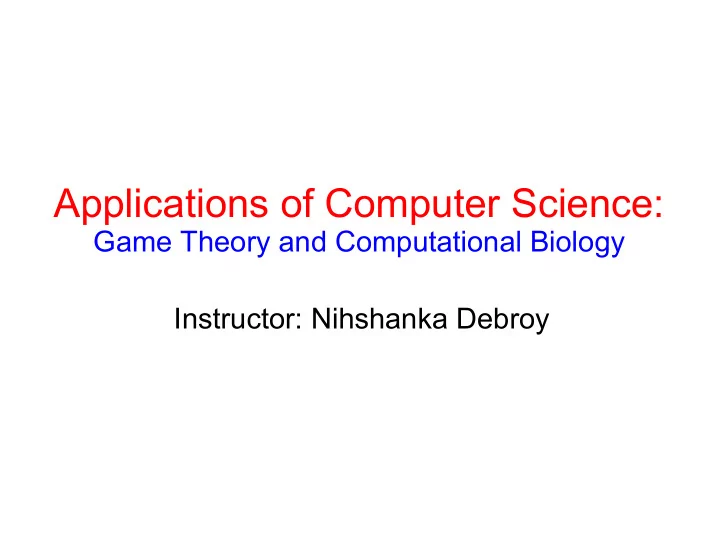

Applications of Computer Science: Game Theory and Computational Biology Instructor: Nihshanka Debroy
Game Theory
What is game theory? ● Study of settings where multiple parties (agents) each have – different preferences – different actions they can take ● Each agent’s utility (potentially) depends on all agents’ actions ● Game theory studies how agents can rationally form beliefs over what other agents will do, and so, how agents should act
Rock-paper-scissors Column player (player 2) (simultaneously) chooses a column 0, 0 -1, 1 1, -1 Row player 1, -1 0, 0 -1, 1 (player 1) chooses a row -1, 1 1, -1 0, 0 A row or column is called an action or (pure) strategy Row player’s utility is always listed first, column player’s second Zero-sum game: the utilities in each entry sum to 0 (or a constant)
“Chicken” • Two players drive cars towards each other • If one player goes straight, that player wins • If both go straight, they both die D S S D D S 0, 0 -1, 1 D not zero-sum 1, -1 -5, -5 S
Dominance ● Player i’s strategy s i strictly dominates s i ’ if – Reward from strategy s i is greater than reward from playing s i ', when used against any of the other players – Weak dominance 0, 0 1, -1 1, -1 strict dominance -1, 1 0, 0 -1, 1 weak dominance -1, 1 1, -1 0, 0
Prisoner’s Dilemma • Pair of criminals has been caught • District attorney has evidence to convict them of a minor crime (1 year in jail); knows that they committed a major crime together (3 years in jail) but cannot prove it • Offers them a deal: – If both confess to the major crime, they each get a 1 year reduction – If only one confesses, that one gets 3 years reduction confess don’t confess -2, -2 0, -3 confess -3, 0 -1, -1 don’t confess
“Should I buy an SUV?” accident cost purchasing cost cost: 5 cost: 5 cost: 5 cost: 8 cost: 2 cost: 3 cost: 5 cost: 5 -10, -10 -7, -11 -11, -7 -8, -8
Best-response strategies ● Suppose you know your opponent’s strategy – E.g. your opponent plays rock 50% of the 0, 0 -1, 1 1, -1 time and scissors 50% ● Best strategy for you ? ● Rock gives .5*0 + .5*1 = 1, -1 0, 0 -1, 1 .5 ● Paper gives .5*1 + .5*(-1) = 0 -1, 1 1, -1 0, 0 ● Scissors gives .5*(-1) + .5*0 = -.5 ● So the best response to this opponent strategy is to (always) play rock
Nash equilibria of “chicken” D S S D D S 0, 0 -1, 1 D 1, -1 -5, -5 S – (D, S) and (S, D) are Nash equilibria ( no player can benefit by changing his or her strategy while the other players keep theirs unchanged ) • Strict Nash equilibria: changing your strategy will make you strictly worse off
The presentation game Presenter Put effort into Do not put effort into presentation (E) presentation (NE) Pay attention 4, 4 -16, -14 (A) Audience 0, -2 0, 0 Do not pay attention (NA)
The presentation game Presenter Put effort into Do not put effort into presentation (E) presentation (NE) Pay attention 4, 4 -16, -14 (A) Audience 0, -2 0, 0 Do not pay attention (NA) • Nash equilibria: (A, E), (NA, NE) • Can see that some equilibria are strictly better for both players than other equilibria, (Pareto-domination)
What is mechanism design? ● In mechanism design, we get to design the game (or mechanism) – e.g. the rules of the auction, marketplace, election, … ● Goal is to obtain good outcomes when agents behave strategically ● Mechanism design often considered part of game theory ● Sometimes called “inverse game theory” – In game theory the game is given and we have to figure out how to act – In mechanism design we know how we would like the agents to act and have to figure out the game
Example: (single-item) auctions • Sealed-bid auction: every bidder submits bid in a sealed envelope • First-price sealed-bid auction: highest bid wins, pays amount of own bid (does not make sense to bid your true valuation - even if you win, your utility will be 0…) • Second-price sealed-bid auction: highest bid wins, pays amount of second-highest bid (always makes sense to bid your true valuation) bid 1: $10 first-price: bid 1 wins, pays $10 second-price: bid 1 wins, pays $5 bid 2: $5 bid 3: $1 0
Computational issues in mechanism design • Algorithmic mechanism design – Sometimes standard mechanisms are too hard to execute computationally – Try to find mechanisms that are easy to execute computationally, together with algorithms for executing them • Automated mechanism design – Given the specific setting and the objective, have a computer solve for the best mechanism for this particular setting Two examples of mechanism design problems ● Kidney exchange problem ● High-school assignment problem
Where is game theory used? ● Economics (& business) – Auctions, exchanges, price/quantity setting by firms, bargaining, funding public goods, … ● Political science – Voting, candidate positioning, … ● Philosophy – Conventions, ethics, … ● And of course… Computer science! – Game playing programs, electronic marketplaces, networked systems, … – Computing the solutions that game theory prescribes
Computational Biology
Electrostatic Potential Map
Recommend
More recommend